Smartick is an online math learning program for children aged 4–14. It delivers daily 10–15 minute lessons that adapt to each student’s level using AI. The Smartick site reports high user satisfaction (4.5/5 on Trustpilot) and over 15,000 app reviews. This article gives an overview of Smartick’s features, pricing, pros and cons, and compares it to alternatives.
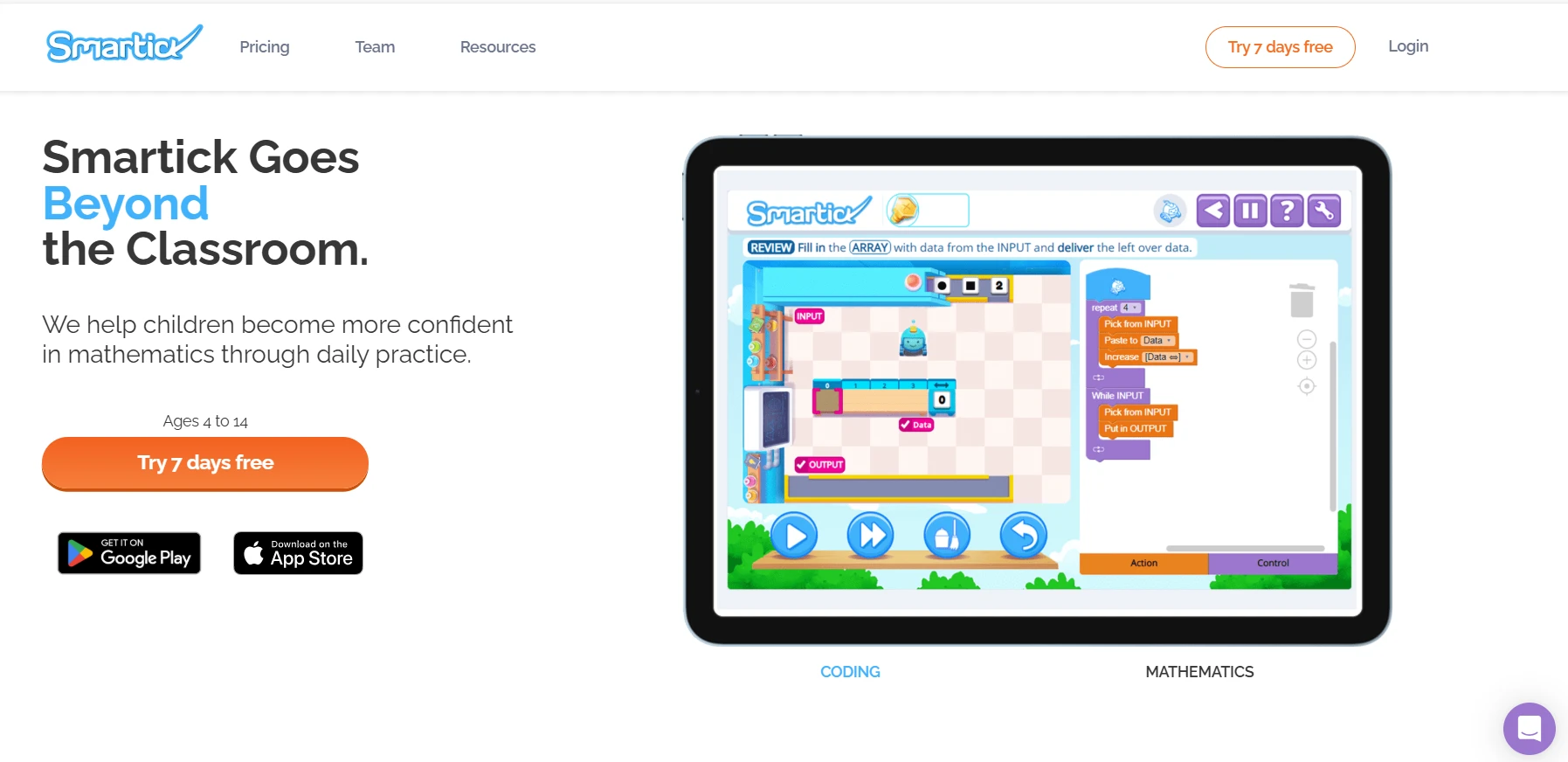
Smartick Reviews and Testimonials
Many parents and kids praise Smartick’s engaging interface and fun learning style. For example, a GeekDad review calls the program “wildly addicting and educational,” saying it revolutionized their homeschool routine. Smartick’s own materials claim that 83% of children improve their math scores and 94% improve in logic skills with daily use. Review sites show mostly positive feedback – the company highlights a 4.5/5 Trustpilot rating. Users especially like the short daily format and reward system (kids earn “ticks” and diplomas for achievements). However, some note downsides: one review warns that Smartick can be a bit expensive for families with multiple children, and every child needs a separate subscription.
Smartick Pricing
Pricing Range
Smartick is sold by subscription. Published rates (in USD) show a monthly plan around $49.99, a quarterly plan (~$147/quarter or $44.99 per month), and an annual plan (~$34.99 per month). (Smartick’s blog has also noted rates from $20–$40/month, suggesting older pricing or discounts.) Families should verify current prices on Smartick’s site, as they may vary by region.
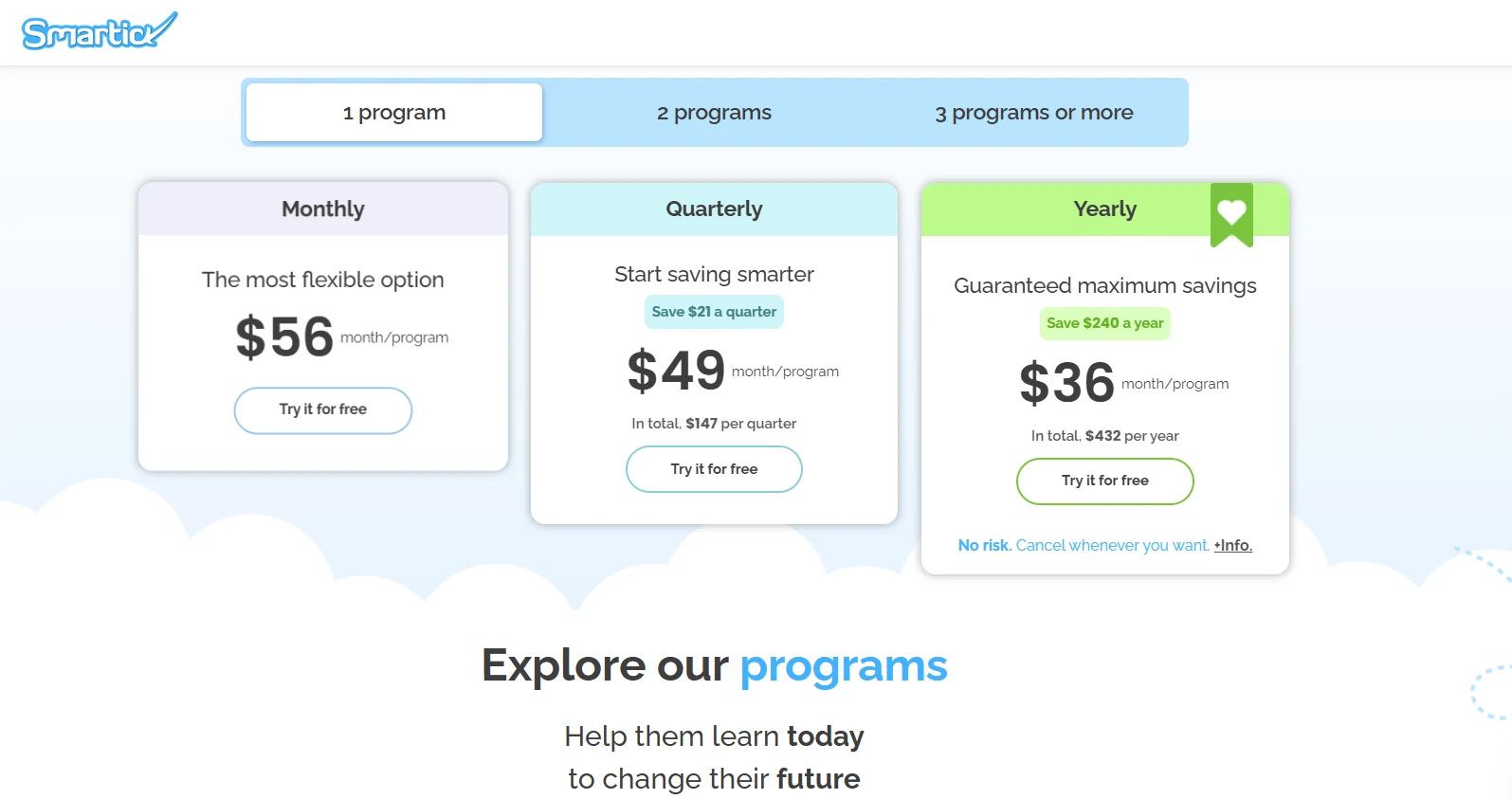
What Students Say About Smartick Pricing
Feedback on pricing is mixed. Some parents feel the cost is justified by the quality, but others mention it as a downside. In one review summary, experts note Smartick “is not the cheapest” option. Since each child needs their own account, the total cost can rise with siblings
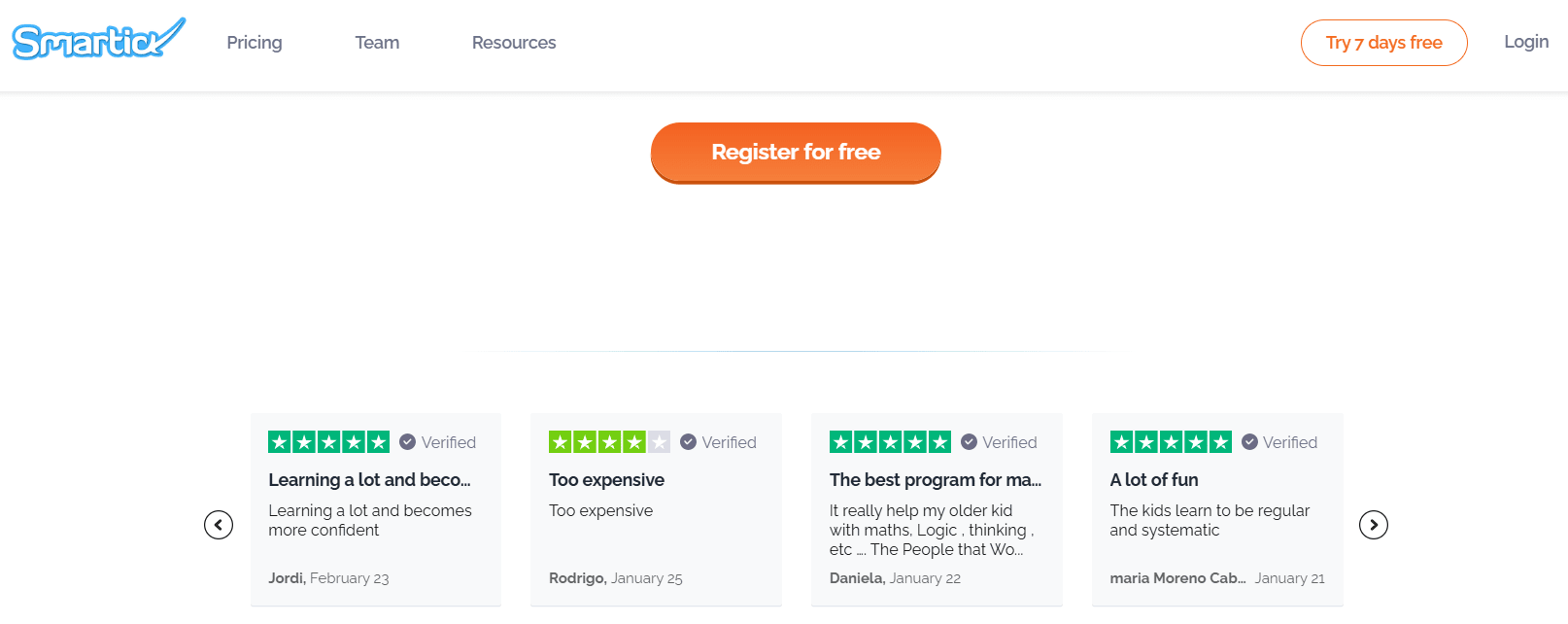 .
.
Hidden Costs
There are no hidden fees besides the subscription. Smartick runs entirely online; families only need a computer or tablet and internet access. Note that, unlike some family plans, Smartick charges per child (with a multi-child discount):contentReference[oaicite:16]{index=16}. Other expenses might include any optional coaching or materials, but Smartick itself requires only the subscription fee.
How Smartick’s Pricing Works
When you subscribe, Smartick charges up front for the selected period (monthly, quarterly, or yearly). The service auto-renews each term until you cancel. You can manage or cancel your plan through the account settings or by filling out a cancellation form as described in Smartick’s terms. Smartick uses secure online payments (credit/debit or PayPal).
Free Trial
Smartick offers a 7-day free trial with full access to the program. You can sign up and use Smartick for one week without charge. If you cancel before the trial ends, you won’t be billed.
Refund Policy
Smartick’s refund policy depends on the plan. Advance payments are generally non-refundable, except in specific cases. For monthly and quarterly plans, there are no refunds after you pay. Yearly plans are partially refundable: if you cancel early, the unused portion is returned prorated, using the lowest effective rate. In short, no refunds on short plans; yearly subscribers can get a pro-rated refund if they quit early.
Smartick Alternatives
- Khan Academy: A free, nonprofit platform with thousands of math (and other subject) videos and exercises. It offers practice in many grade levels at no cost.
- Prodigy Math Game: A free, game-based math practice program. It turns math problems into an RPG adventure that many kids enjoy.
- IXL: A popular subscription-based learning site covering math (and other subjects). It offers skill practice and quizzes aligned to school topics.
- DreamBox Learning: An adaptive online math program that personalizes lessons, similar in concept to Smartick but targeted at elementary and middle school standards.
- MyEngineeringBuddy (MEB): An online tutoring service specializing in math, engineering, and college-level subjects. Instead of automated lessons, MEB provides live one-to-one tutoring (starting around $20/hour). MEB is more focused on older students and homework help, whereas Smartick is a self-paced app for younger learners.
How it Works?
For Students
Kids start Smartick by taking a short placement session so the app finds the right level. Then each day they log in to do a ~15-minute lesson. The AI adjusts the questions to their skill level and pace. As they answer problems, students earn virtual “ticks” (points) for success. After the lesson, kids can spend ticks in the Smartick virtual world or games. These activities are designed to be fun and to train cognitive skills (like memory, attention, and reasoning) while learning math. Smartick’s step-by-step problems and tutorial videos help students understand concepts without needing a live tutor.
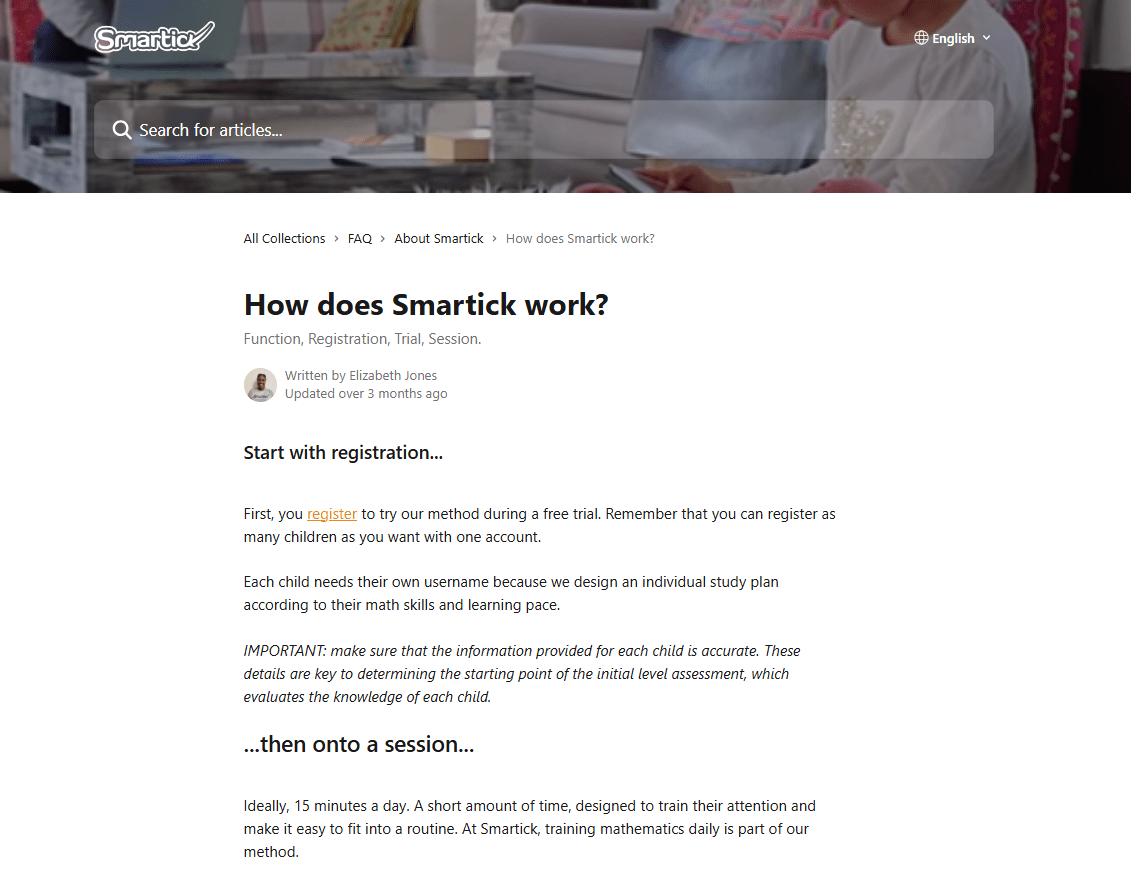
For Tutors (Parents/Educators)
“Tutors” in Smartick’s terms typically means parents or teachers supervising students. As a tutor, you set up your child’s account and choose the subscription. You can pause or adjust the plan at any time. Smartick sends email reports and notifications after each session, so you always know how the child did. There is a parent/teacher dashboard that shows progress, speed, and areas mastered or needing work. Smartick also provides a pedagogical support team — experts you can contact by email or chat if you have questions or need help. In summary, tutors/parents mainly monitor progress and encourage the child; the lessons themselves are self-guided by Smartick.
FAQs
Q: Can I become a Smartick tutor or teacher?
A: Smartick is a self-learning app, not a tutoring platform. There are no live tutor positions within Smartick. Students learn independently from the program. (Smartick does, however, have a support team for users.)
Q: How do I cancel my Smartick subscription?
A: To cancel, log into your Smartick parent account and go to settings. You can request cancellation at any time. Monthly and quarterly plans simply stop renewing. If you have a yearly plan, Smartick will refund the unused portion as explained in their policy.

Q: Is Smartick appropriate for a child with learning difficulties (dyscalculia)?
A: Yes. Smartick includes a special cognitive training program developed for children with dyscalculia. All students work at their own pace and receive positive feedback to build confidence.
Q: What age groups and subjects does Smartick cover?
A: Smartick is designed for ages 4–14. It focuses mainly on foundational and pre-algebra math. Recent updates also include logic exercises and an introductory coding component. (There is also a separate reading program in some languages.)
Q: How much does Smartick cost and is there a free trial?
A: Smartick costs a monthly fee (roughly $35–$50 USD depending on plan and region). There is a 7-day free trial for new users. After the trial, you need to subscribe or cancel. Multiple children need separate subscriptions, though extra-account discounts are available.
Q: How is Smartick different from MyEngineeringBuddy (MEB)?
A: Smartick and MEB serve different needs. Smartick is an app for young children’s math practice (self-paced and automated). MyEngineeringBuddy is a live tutoring service for older students. MEB connects students with human tutors and charges per hour (around $20/hr starting). In contrast, Smartick’s AI program provides instant feedback and rewards for kids without needing a live tutor. Choose based on your child’s needs: app-based practice (Smartick) vs. personalized human tutoring (MEB).
Q: What support does Smartick provide if I have questions?
A: Smartick offers support via email and chat. The website FAQ and help center cover most topics. For additional help, Smartick’s pedagogical team can answer questions about lessons or progress. They also have a system that notifies tutors/parents of each session’s results by email.

Q: How do students find Smartick?
A: Families sign up for Smartick directly through the website. Schools or learning centers in some countries also offer Smartick to students. Its wide reach (used in 180+ countries) comes from online advertising, word-of-mouth, and partnerships. There is no separate “student acquisition” step like booking a tutor – you simply create an account online and subscribe or start the free trial.
Smartick Company Information
Founders and History
Smartick was founded in 2009 in Spain by Javier Arroyo and Daniel González de Vega. Both founders have backgrounds in education and tech. They launched Smartick to address the global problem of children struggling in math. The company initially grew in Spain and later expanded internationally, with English versions for the U.S. and U.K. in 2016 and a Portuguese version in Brazil by 2021.
Mission and Vision
Smartick’s mission is to help every child reach their full potential in math and beyond. The company emphasizes a personalized, game-like method of learning. Their website states they aim to empower children “to excel in math and beyond” by providing a distinct personalized curriculum for each student. They also highlight fostering confidence and problem-solving skills through fun, short daily sessions.
Unique Features (USP)
Key Smartick features include its adaptive AI engine, short daily sessions, and gamified learning. After an initial assessment, the AI crafts a customized study plan for each child. The 15-minute sessions keep practice brief and consistent. Smartick uses rewards like “ticks” and virtual diplomas to motivate kids. It also includes interactive games that train cognitive skills (perception, memory, attention, reasoning) while learning math. In addition, Smartick has a separate cognitive training program (called PEC) designed to strengthen mental calculation and help children with dyscalculia. This focus on brain-training games and AI adaptation is a unique selling point compared to more traditional drills.
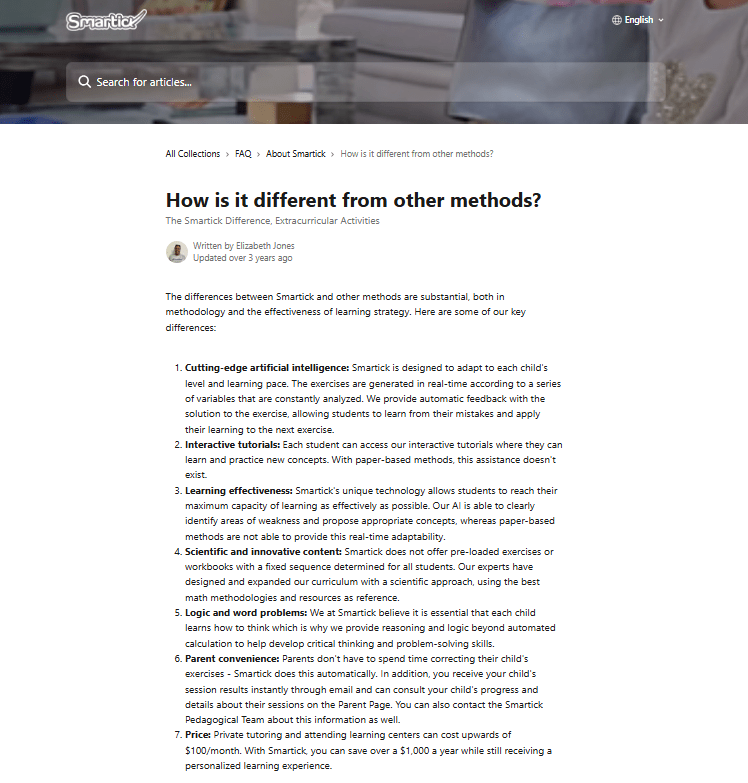
Drawbacks of Smartick
Smartick’s main downsides include cost and flexibility. Because it is subscription-based, some families find it relatively expensive, especially for multiple children. Each child must have their own account (with no free multi-child account). Unlike a live tutor, Smartick cannot adjust on-the-fly to a child’s mood or questions beyond its programmed responses. It is also not aligned to any specific school curriculum, so it may cover or omit topics differently than a child’s class. Lastly, an internet-connected device is required; without it, Smartick cannot be used.
Comparison with MyEngineeringBuddy
Smartick and MyEngineeringBuddy (MEB) serve different audiences. Smartick is an automated math program for young learners, while MEB offers live one-on-one tutoring in advanced math, engineering, and STEM subjects. In terms of cost, Smartick charges a monthly subscription (~$35–$50/month), whereas MEB charges by the hour (tutors start around $20/hour). Smartick lessons are fixed daily sessions, whereas MEB sessions are scheduled with a tutor. Smartick is better for building routine practice and confidence in kids; MEB is better for in-depth help on homework or college-level topics. You might prefer Smartick for self-paced daily learning and games, and MEB if you want a personal tutor working directly with your child.
Customer Support and Policies
Smartick provides several support options. After each lesson, parents get an email with the child’s results (number of questions, accuracy, topics). The parent dashboard offers detailed progress reports. For personal help, Smartick has a pedagogical support team — educators who answer questions by email or chat. Their website also includes a Help Center with FAQs. Regarding policies, Smartick’s Terms of Service explain subscriptions and cancellations. As noted, paid subscriptions auto-renew and are generally non-refundable except for prorated yearly plans.
Global Reach and Localization
Smartick is used worldwide. The company states it is available in over 180 countries, and their platform can adapt to multiple languages. The math program was originally in Spanish, with English (U.S. and U.K.) and Portuguese versions now available. Some regions may also use localized content (for example, measurement units or math terminology). The interface uses simple English wording and intuitive icons, which helps children worldwide engage with the material. Smartick continues to expand to new markets.
Smartick’s Future Plans (Including AI)
As an AI-powered platform, Smartick’s future plans likely involve expanding and enhancing its adaptive learning features. It already uses AI to personalize lessons and supports cognitive training games. Recent additions (like the reading and coding sections, and the cognitive PEC program) suggest growth into new subjects. While the company doesn’t publicly list specific roadmaps, analysts expect Smartick to keep refining its AI and possibly add more content (e.g. science or languages) to stay competitive in edtech. The continued focus on gamification and executive function training indicates Smartick will advance those areas as well.
FAQs About Smartick
Q: What ages and subjects does Smartick cover?
A: Smartick is designed for children ages 4–14. It focuses on math fundamentals (counting, arithmetic, pre-algebra, etc.). The program also includes logic puzzles and, more recently, basic coding and reading exercises. It is not aligned to a specific school syllabus but covers general math concepts for its age range.
Q: How long is each Smartick session?
A: Each daily session is about 10–15 minutes long. The goal is short, consistent practice. Because sessions are short, kids can do them independently and stay motivated.
Q: Is Smartick available on mobile devices?
A: Yes. Smartick offers apps for tablets and phones (iOS and Android) as well as a web version. The mobile apps have high ratings (4.3 on the App Store with 500+ reviews), making it easy for children to practice anywhere.
Q: Can multiple children share one Smartick account?
A: No. Smartick requires a separate subscription for each child. Each student’s program is personalized, so accounts are not sharable. (The good news: additional children get a discounted rate.)
Q: How do I cancel Smartick?
A: You can cancel any time via your account dashboard or by contacting support. Canceling prevents the next renewal. Remember that cancelation does not prorate money already paid for the current period, except under Smartick’s yearly-plan refund rules.
Q: What if I need to pause Smartick?
A: Smartick allows taking breaks. You can suspend the subscription from your account settings and resume later without penalty (though the billing schedule may adjust accordingly). It’s best to check the Help Center for details.
Q: Does Smartick work on all subjects?
A: Currently Smartick covers math and related skills (reasoning, logic, some coding basics). It has a separate track for reading in some languages. It does not cover other subjects like science or social studies.
Q: How does Smartick compare to hiring a live tutor?
A: Smartick’s lessons are automated and short; a live tutor gives longer, personalized sessions. Smartick’s cost ($20–$50/month) is often lower than regular tutoring ($25–$80/hour). Smartick works well for daily practice and confidence-building. A tutor can answer questions and teach flexibly. In fact, Smartick itself notes it is like a math tutor at home, but on your schedule. Which is better depends on your needs.
Conclusion
Smartick’s strengths lie in its adaptive, daily-format lessons and engaging games. Many users report that kids look forward to the 15-minute sessions. The built-in rewards and cognitive games make math practice fun. Smartick also offers strong parent support (emails and dashboards) and special content for learners who need extra help. On the downside, it can be relatively costly (especially per child), and it may not replace the depth of one-on-one tutoring. In summary, Smartick is a powerful tool for building math skills and habits. Families who want live tutoring might consider an alternative like MyEngineeringBuddy, but for many children Smartick’s convenient, gamified approach works very well.

